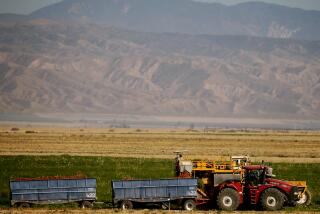State Official Tours Canyons at Heart of Development Battle
DIAMOND BAR â To the dismay of city officials who were given no formal notice of his arrival, the stateâs environmental chief hiked into one local canyon last week and then flew over it and another canyon--both of them embroiled in controversy over proposed developments.
Local environmentalists were buoyed by the visit of California Secretary for Resources Douglas P. Wheeler, who said he would do what he could to bring about compromise in the battles over 171-acre Sandstone Canyon and 6,500-acre Tonner Canyon.
Wheeler pledged to encourage the Diamond Bar City Council, city staff members and developers to work with environmentalists worried about development of Sandstone and Tonner.
Upon his appointment by Gov. Pete Wilson more than two years ago, Wheeler--a former Sierra Club executive director and an Interior Department official in the Ford and Nixon administrations--pledged to aggressively mediate disputes between environmentalists and business interests.
To that end on Friday, Wheeler took off his dress shoes and put on hiking boots for a trek through part of Sandstone Canyon with environmentalists who want to prevent a proposed $170-million development project there.
Later, by helicopter, Wheeler toured Tonner Canyon, which also is facing development pressures.
In Sandstone Canyon, two major developers, along with city and school officials, hope to build a junior high school, a 28-acre park with ball fields and nature trails, a 290,000-square-foot commercial area and 200 single-family houses in the $500,000 range.
The project, just west of the Orange (57) Freeway, would remove about 800 coast live oak trees. A half-mile portion of the canyon would be filled with an 80-foot-deep layer of earth scraped from surrounding ridges.
Tonner Canyon for several years has also been attracting development proposals, ranging from residential to commercial and recreational projects. The crescent-shaped canyon stretches for eight miles across three counties--Los Angeles, Orange and San Bernardino--and three cities--Brea, Diamond Bar and Chino Hills.
Tonner Canyon has abundant plant and wildlife, including threatened and rare species. In the 1970s, it was designated as a county âSignificant Ecological Area.â
After hiking through the dense undergrowth and oak woodlands of Sandstone Canyonâs southern end, Wheeler said it is difficult to ignore criticisms of a preliminary environmental study on a plan to build houses, commercial development and school there.
He cited a critical letter written by an official with the California Department of Fish and Game, one of the 15 state agencies and boards under Wheelerâs domain.
In his letter, Department of Fish and Game official Fred Worthley questioned the environmental studyâs contention that a loss of oak and walnut trees in the canyon would not represent a significant biological impact.
Wheeler was invited to visit at the request of Republican Assemblyman Paul V. Horcher, a former Diamond Bar councilman who said he reluctantly decided to intervene in the longstanding local debate on open space versus development.
Horcher said he did not invite City Council members or city officials because many of them have thwarted previous efforts to discuss preserving the canyons.
âTheyâve had years to work on this,â he said. âPeople are shouting. The battle lines are hardening.â A leadership vacuum opened, Horcher said, and he decided to fill it.
City Manager Terrence L. Belanger was miffed that Horcher did nothing to arrange for Wheeler to get city officialsâ views. âI would presume that just out of common courtesy they would want to have consulted with us,â Belanger said.
Belanger said he plans to write Wheeler because âit is important we create a bridge between his office and the city.â
Mayor Gary G. Miller said, âI donât know why Wheeler came. I donât know what conclusions he arrived at. It sounds like politics . . . but if he can figure out a way to purchase Tonner Canyon as a state park, Iâd wholeheartedly support that.â
Miller has avoided public comment on Sandstone Canyon and says he will not vote on the issue when it comes before the council. Two and a half years ago, during a period he was not a councilman, Miller briefly owned 78 acres of the canyon before selling it to one of the current development companies, R-N-P Development Inc.
Wheelerâs suggestion that all sides in the debate should sit down comes belatedly, said Jan C. Dabney, spokesman for the two major developers of Sandstone Canyon. âPerhaps Mr. Wheeler should have been here two years ago talking about this,â Dabney said.
Already, Dabney said, the developers, with the involvement of city officials, have gone to great lengths and expense to ensure that portions of Sandstone would be protected.
But Don Schad, a naturalist who has been leading a fight to thwart development in Sandstone, said city officials do not share his dream of preserving the canyons.
Schad, who also founded the nonprofit Tonner Canyon Conservancy, said he is grateful that Wheeler came, and he hopes the state official can suggest ways to fund preservation of both canyons.
More to Read
Sign up for Essential California
The most important California stories and recommendations in your inbox every morning.
You may occasionally receive promotional content from the Los Angeles Times.










